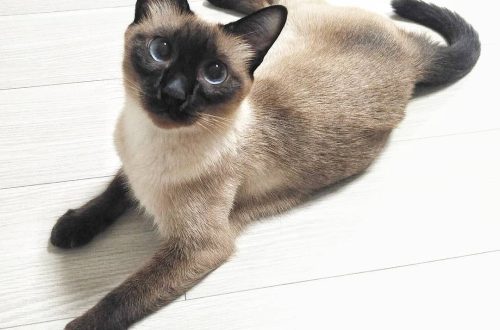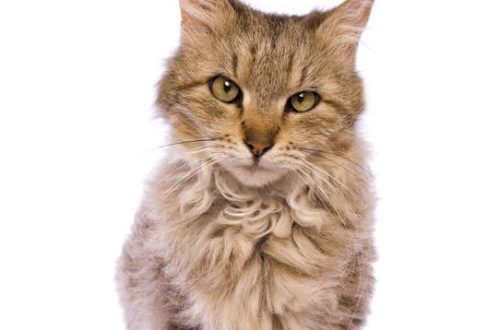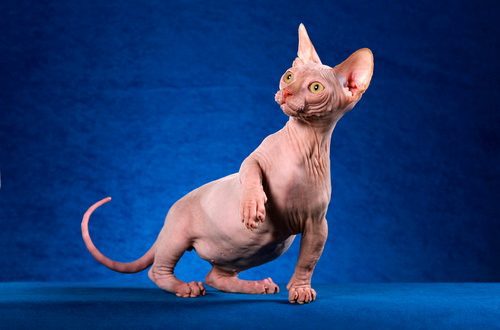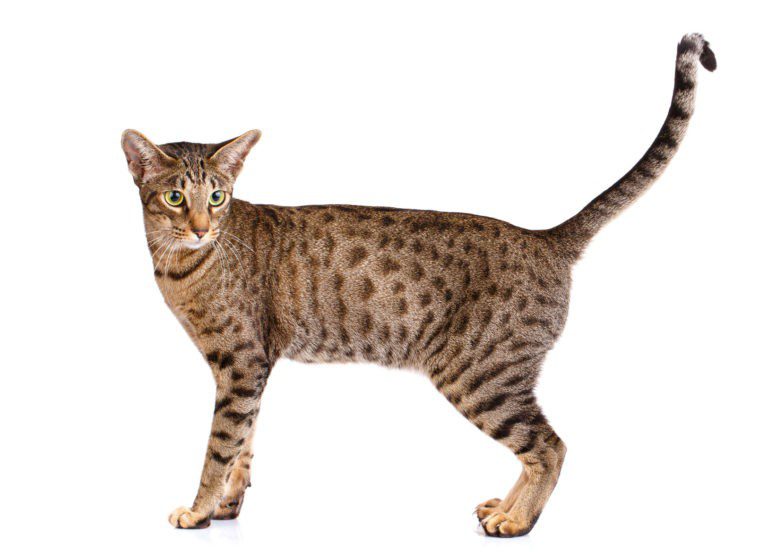
Ocicat
The Ocicat is a rare breed with a spotted-ticked coat color, bred in the USA by crossing Siamese, Abyssinian and American Shorthair cats.
Contents
Characteristics of Ocicat
| Country of origin | USA |
| Wool type | shorthair |
| Height | 26-32 cm |
| Weight | 3–6 kg |
| Age | 15–17 years old |
Basic moments
- Like the Siamese, Ocicats are not averse to “talking”, but, unlike their Oriental relatives, they do not suffer from excessive talkativeness.
- The name “Ocicat” is formed from two words: “ocelot” – a wild predator of the cat family and the English noun “cat” – a cat.
- The breed does not require complex hygienic care, so the only thing the owner will have to tinker with is brushing their teeth and gums, which are not very healthy in representatives of this family.
- With some effort, it is easy to raise a “substitute” for a lap dog from an Ocicat, masterfully aporting balls, responding to its own nickname and obediently executing commands.
- The closest relatives of the breed are the Aztec cats, which are a varietal of the Ocicats with a striped-marble coat color. So far, this cat family is recognized only by GCCF and is rarely exhibited at exhibitions.
- Along with the genes responsible for an interesting coat color, Ocicats inherited from their Abyssinian and Siamese ancestors a predisposition to a number of diseases that are not always possible to diagnose in a timely manner.
- The breed is not prone to escaping. Although prudent owners prefer to walk their pets in harnesses, going far from home is not in the rules of Ocicats.
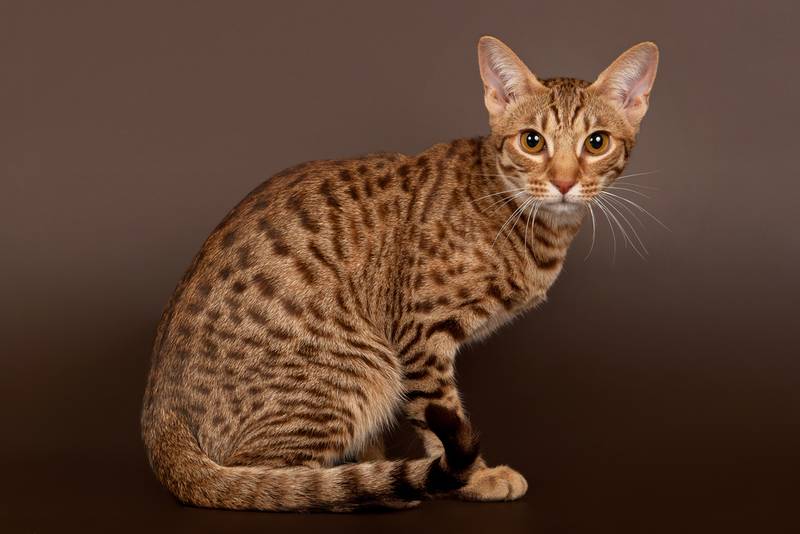
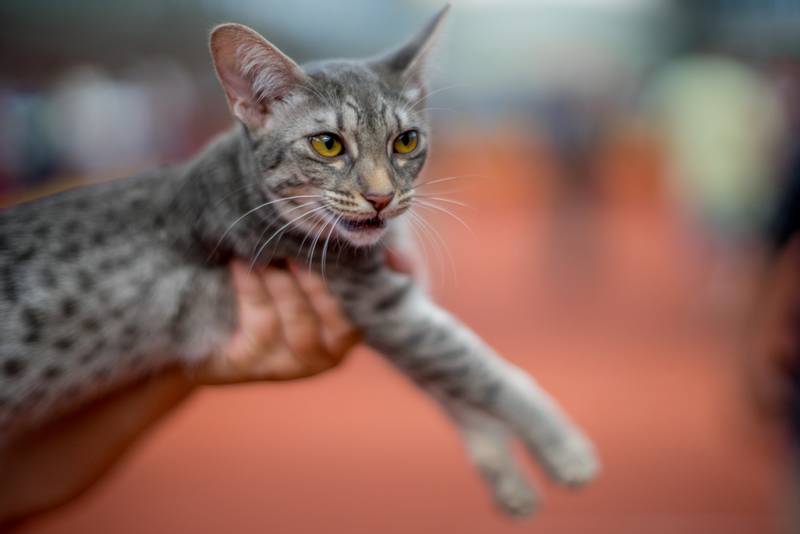
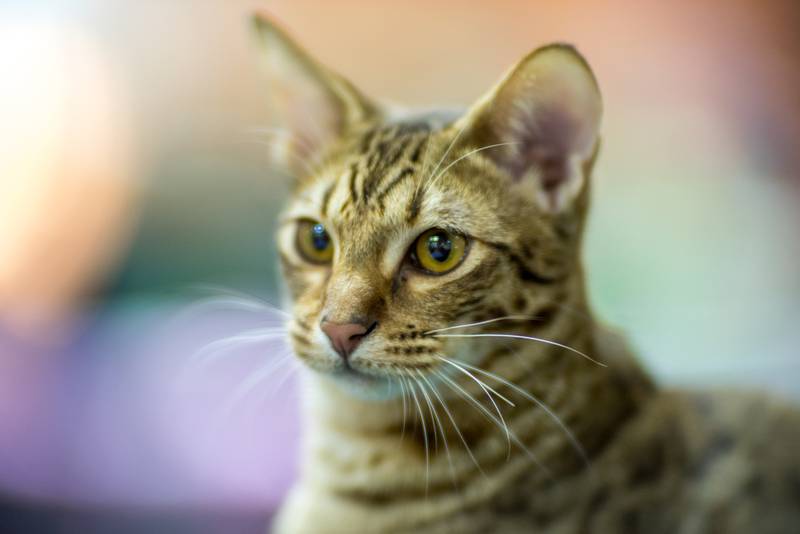
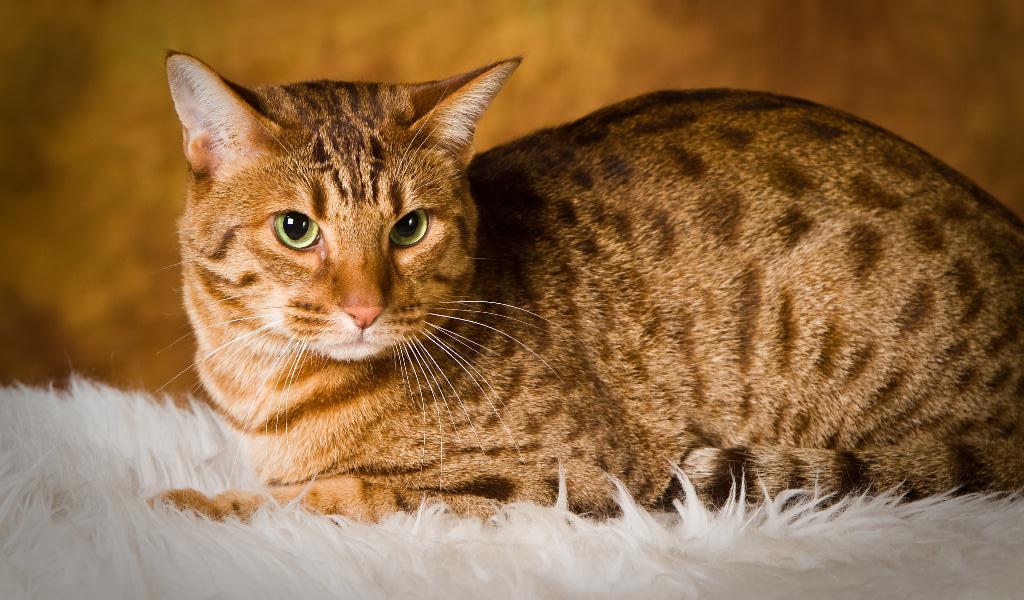
Ocicat is a sociable slicker with the plasticity of a wild panther and a moderately gentle character, for the possibility of owning which you will have to pay a tidy sum. Usually, the breed is recommended to people who have had time to get fed up with feline independence and who want to see a sympathetic, playful friend next to them. Unlike most other cats, the Ocicat will not tire of reminding the owner of his own presence in the apartment and bringing clockwork mice. In addition, he has an innate “accompaniment mania” of the owner, whether it’s a road trip or a nightly march to the refrigerator.
History of the Ocicat breed
Despite the strong external resemblance to the ocelot, the Ocicats are not related to wild cats. The breed was born in the US state of Michigan in 1964, and completely unplanned. It all started with the fact that felinologist Virginia Dale wanted to breed a Siamese cat with tabby hair. To implement her plan, the breeder crossed a Siamese with an Abyssinian , and then turned the reverse operation and mated the mestizo born from this pair with another Siamese cat . However, something in the genetic code of the embryos went wrong, and, along with the tabby babies, the fluffy ward of the breeder brought an unusual cream kitten strewn with contrasting spots.
The newborn cat was named Tonga, castrated in due time and put up for sale for a symbolic ten dollars. Dale herself temporarily said goodbye to the dream of tabby Siamese, fully concentrating on breeding a new breed of spotted cats. A few months later, Tonga’s parents gave birth to another baby with an ocelot color – Dalai Dotson, to whom the felinologist treated more carefully. As a result, the cat was registered with the CFA and managed to participate in the breeding experiments of the breeder.
Between 1966 and 1980, a little less than a hundred spotted kittens were born in the United States, and this happened already with other owners – Mrs. Dale herself temporarily retired. At first, only Abyssinians and Siamese were involved in the process of creating the breed , but later American Shorthair cats were involved in the process , which brought silver tones to the color of Ocicats. In 1986, the “Michigans” were officially recognized by the CFA, issuing a ban on their further crossing with genetic relatives – Siamese , Abyssinian and American Shorthair cats .
For your information: not all modern Ocicats are born spotted. From time to time, the so-called varieties of the breed are born – individuals that have a constitution corresponding to the standard, but with wool of an unusual color, in which contrasting marks are either completely absent or merge with the background.
Video: Ocicat
Ocicat breed standard
The breed owes its bright, wild charisma to the exotic color and athletic build, thanks to which all Ocicats successfully “mimic” the distant relatives of the leopard. Cats are almost always smaller than males, but their elegance is purely external. Any Ocicat, be it a cat or a cat, is far from being an ascetic pet, as it might seem at first. Spotted “girls” weigh from 4 to 5 kg, “boys” can “pump up” muscle mass up to 7 kg. At the same time, visually, both of them give the impression of very light, graceful creatures.
Head
Ocicats have broad, wedge-shaped muzzles with a poorly marked stop, a slight curve between the cheeks and chin, and a prominent whisker break. If you look at the animal in profile, its head seems slightly elongated, while in the full face position, the muzzle has a square format. The chins of the Ocicats are well developed, the jaws are strong, the necks are elongated and flexible.
Ears
A medium-sized ear canopy in a permanently “alert” position. The correct cartilage fit is when an imaginary line drawn along the cat’s forehead intersects the ear at an angle of 45°. An additional nuance: if two Ocicats with the same exterior are exhibited in the ring, but one of them has lynx tassels growing on the tips of the ears, preference will be given to it.
Eyes
The breed is characterized by large, almond-shaped eyes with outer corners raised to the temples. The second mandatory requirement of the standard is the distance between the organs of vision, exceeding the length of one eye. The color of the iris is not tied to the suit and can be anything, with the exception of a blue tint.
Frame
The CFA describes the Ocicat as a cat with a long, but dense and athletic body. At the same time, any hint of the roughness of the constitution and clumsiness of movements is excluded and considered as a vice. The chest should be spacious and wide, the back straight or slightly raised in the area between the croup and the lower back. Ideal representatives of the breed are muscular and flexible individuals with even lateral lines.
limbs
The legs of the Ocicat are muscular, powerful and of moderate length. The cat’s feet are compact, tending to the shape of an oval and having five toes on the front paws and four on the back.
Tail
All representatives of the breed have long tails of moderate thickness with a slightly pointed tip covered with dark hairs.
Wool
Ocicats are dressed in smooth, shiny “fur coats” consisting of short and thick hair. The coat should fit snugly against the body, but it should not fluff or bulge.
Color
Immediately characterize the spotted color of the Ocicat as “corresponding to the standard” or “defective”, even experienced breeders are not always able to. In total, felinological associations distinguish 12 “correct” colors of the breed, differing from each other in the contrast of the background and marks. Among them:
- brown;
- chocolate;
- reddish brown;
- purple;
- blue;
- yellow-brown;
- chocolate silver;
- black and silver;
- beige silver;
- blue-silver;
- brown silver;
- lilac silver.
According to the standard, each hair must have a ticked (zonal) color. As for pseudo-leopard marks, they appear where part of the tips of the hairs are tinted in a dark color, and part in a light color. On the body of the Ocicat, both relatively light areas (the lower jaw, the area around the eyelids, the chin part) and dark areas (the end of the tail) are also noticeable.
The brightness of the marks themselves on the body also varies. For example, the spots on the muzzle, paws and tail are darker than the marks on the body. The smearing of the coat pattern and its fading are positioned as exterior flaws, therefore, at exhibitions, cats with such defects are lowered.
How are the dark spots on the body of the Ocicat
Each thoroughbred Ocicat has stripes on the muzzle in the form of the letter “M”. Oval spots begin to appear in the area between the ears, turning into a small “placer” in the lower part of the neck and shoulders. In the vertebral zone, running from the shoulder blades to the tail, the marks are arranged in horizontal rows, with large strokes of spots alternating with contrasting dots. On the thighs, abdomen and shoulder blades of Ocicats, markings are scattered randomly. On the sides there are dark “traces” of a finger-like shape. In the lower part of the legs and on the throat, the spotty pattern is replaced by a “bracelet”, and the more gaps between the ends of the “bracelets”, the better.
The eyes of the Ocicat have black edging surrounded by a light background coat. Special attention deserves the tone of the tail, which in controversial cases is a defining breed trait. In purebred individuals, the tails have contrasting transverse stripes, but the tips are painted in a uniform dark tone.
Disqualifying vices
- The presence of a white medallion or spot (does not apply to white hair around the eyes, on the throat, chin, nostrils, and also to a white background in silver individuals).
- Deformed tail with creases.
- Blue rainbow.
- The number of fingers is more or less than specified by the standard.
- Wool red, cream and torby colors.
- Long fluffy hair.
Character of the Ocicat
The Ocicat is a breed for those who need an affectionate and contact pet with the appearance of a wild savannah. Despite their somewhat brutal appearance, Michigan cats are quite good-natured, and with their desire for communication they do resemble dogs. If a noisy party rumbles in the master’s house, you can be sure that the cat will have time to get acquainted with each of its participants, and will also gain confidence in individual comrades.
Usually the process of establishing contacts with strangers in Ocicats goes like this: hide and seek behind the sofa (for a very short time), carefully sniffing and licking human palms, and, finally, a sudden jump on hands. By the way, the latter may not happen – cats subtly feel someone else’s mood and will never climb to cuddle with emotionally unstable people, as well as those who are cool towards animals. So if the cat defiantly bypasses the knees of one of your friends and buddies, you should think about it. A branded unexpected “bite” from an overabundance of emotions can also take place, and it should be treated condescendingly – in this regard, Ocicats do not differ from their outbred relatives.
As already noted, the habits of the Michigan cat resemble a dog, and very nimble, which cares about everything. Each purr satisfies his own curiosity in different ways, but usually not a single cat will pass by an unlocked kitchen cabinet or an ajar chest of drawers. Moreover, it doesn’t matter to the Ocicat whether the owner hides in these vaults the dream of all mustachioed-striped ones – valerian or simply stores waste paper. Open the door and make any secret public – for the breed in the order of things.
If the Ocicat wants something, he will get it, and if the person does not give what he wants, the cat will take it himself. This behavior applies not only to delicacies hidden in the far corner, but also to absolutely inedible objects. By the way, the Ocicat is a breed in which it is better not to delay lunches and dinners. A hungry pet will not languish in anticipation, but will find and open packages with “drying” on its own, not forgetting to inspect the pots standing on the stove.
True Ocicats are travelers at heart. Unlike most members of the feline family, they do not differ in fanatical attachment to a particular house, so they easily endure moving. True, it is better to transport a purring tourist in your own car – carrying, and indeed, the breed quietly hates any space limiters.
Education and training
It is customary to write about the learning abilities of Ocicats only that they are smart and quick-witted pets, who can easily fetch objects and simple acrobatic stunts. At the same time, it is extremely rare to find information that, like any cats, the descendants of the Siamese and Abyssinians are not eager to obey a person and train simply because the owner requires it.
If you decide to get down to business with the training of the Ocicat, accept the need for compromises, which will often have to be made. Some breeders generally recommend relying on the inclinations of the breed, since by stimulating the cat to do what he obviously likes, you dramatically increase your chances of success. For example, Ocicats love to jump, which means that it will not be difficult to teach a pet to take small barriers and fly into the hoop ring.
The Ocicat has a good memory and excellent self-learning abilities inherited from the Abyssinians , so the cat learns the list of basic commands quickly. For a pet to learn to fulfill the requirements “Come!”, “Sit!”, “Stand!”, a classic training program is enough. Special literature, for example, the book “Training a Cat in 10 Minutes” by Miriam Fields-Bambino or “How to Raise Your Cat” by Ellis Bradshaw, will also help to broaden one’s horizons and learn new techniques for effectively influencing an animal.
Raising a small kitten is easier when a trained adult cat already lives in the house. Obeying the animal hierarchy, the baby mirrors the behavior of an adult comrade and makes fewer mistakes. If the Ocicat is the only pet in the apartment, the owner will have to take on the role of mentor. As for toilet training your pet, there are no difficulties here. Michigan cats are naturally clean. If there is no familiar tray nearby (for example, on the road), they prefer to be patient or persistently remind of their needs. Ocicat kittens brought to a new home also quickly get used to the bath with filler and willingly scratch in it, hiding traces of “wet deeds”.
Maintenance and care
A curious and restless Ocicat needs to be provided with enough toys so that he does not adapt your favorite souvenirs instead. Moreover, the shopping list should include not only balls and clockwork mice, but also complex cat puzzles that the breed loves. A high gaming complex will not be superfluous either – at his leisure, the spotted extrovert likes to transform into a conqueror of peaks and a spy who suddenly emerges from a plush “apartment”.
In addition to toys and bowls for food, the Ocicat will need to be provided with a scratching post and a tray. Some breeders recommend putting two trays for one individual at once, since the breed is extremely clean and does not like to go into the filler, which even smells a little. At the same time, plastic baths should be placed as far as possible from the feeding place: for cats, “dining room” and “toilet” are incompatible concepts.
Locking an Ocicat within four walls for fear that a rare cat will be stolen or lost by itself is wrong. It is possible and necessary to walk a pet, but it is better to control its movement outside the house with a harness. By its own will, the purr will not run away, but, noticing a dog nearby, it can get nervous and start looking for salvation in the trees.
Hygiene
As for hygiene procedures, everything here is elementary – the Ocicat does not need to be combed endlessly, pouring liters of conditioners and other cat cosmetics. Once a week, it is recommended to go over the pet’s body with a brush or a rubber mitten, and then rather to collect dead hairs and massage the skin, rather than for the sake of full combing.
The ears of the Ocicat are cleaned as needed, but it is a must to look inside the ear funnel once every few days. For the hygiene of the hearing organs, ordinary pharmaceutical compositions like Cliny, Hartz and a soft piece of textile or a cotton swab are suitable. Ocicat teeth are problematic, with a predisposition to the formation of tartar, so they need to be cleaned daily. To do this, you will have to purchase a cat toothbrush with massage spikes and paste.
If your cat is putting on a “concert” while brushing your mouth, try replacing your traditional toothpaste with something called a liquid toothbrush. This veterinary tartar remover is added to the drinking water bowl and works when the animal comes to drink. At the same time, owners of individuals with sensitive immunity, suffering from allergies, should not get carried away with such products and consult a veterinarian before using them.
Feeding
A healthy ocicat with the same appetite absorbs both high-quality “drying” of super-premium and holistic classes, and natural food. The latter concept does not mean dishes from the master’s table, but a standard set of products that is useful for any domestic predator. This is, first of all, lean meat and offal (up to 70% of the total serving volume), low-fat sour-milk products and pitted boiled sea fish (no more than twice a week). Of the cereals for cats, rice is the most harmless. From vegetables – carrots and pumpkin. Once a week, the cat is allowed to be treated with a chicken yolk or a whole quail egg.
Since Ocicats have problems with teeth and gums, from time to time the animal should be given something rough to chew on, such as bird and beef cartilage or tendons. In addition, purchased vitamin complexes with taurine will have to be introduced into the natural diet, the lack of which negatively affects the vision and general immunity of the breed. Ocicats eat willingly, do not refuse supplements, and do not suffer from a tendency to obesity. However, it is harmful to feed animals, especially castrated and sterilized ones. The Ocicat will never look like a ball-shaped fluffy, like, for example, the British. His lean constitution is the result of a complex game of genes, to go against which is at least pointless.
Health and Disease of Ocicats
Despite the fact that the Ocicat is an artificially bred breed, its representatives have good health. With proper care, Michigan cats live up to 15-18 years, although felinologists assure that such an age range is far from the limit. As for genetic ailments, the probability of their inheritance is not one hundred percent. Some pathologies of the Siamese and Abyssinians pass to the Ocicats unchanged, and some – in an autosomal recessive way (when the pet is a carrier of a defective gene, but does not suffer from the disease itself).
The most troublesome diseases that Ocicat can get from their ancestors are renal amyloidosis and erythrocyte pyruvate kinase deficiency. In the first case, the symptoms are a sharp weight loss, constant thirst, problems with urination, in the second – a decrease in appetite and an increase in the volume of the abdomen. Often, ailments occur without visible symptoms, so you should keep your finger on the pulse and look to the veterinarian at the slightest change in your pet’s behavior.
The Siamese rewarded the Ocicat with a propensity for hypertrophic cardiomyopathy. In addition, representatives of the breed are carriers of the recessive gene for retinal atrophy, which is transmitted from breeders to offspring. So, when buying a kitten in American catteries, feel free to ask the seller for the results of the examination of the litter for a predisposition to this disease – testing for the detection of genetic retinal atrophy in the United States has been carried out for a long time and successfully.
How to choose a kitten
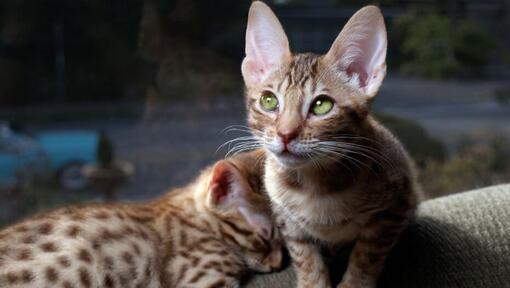
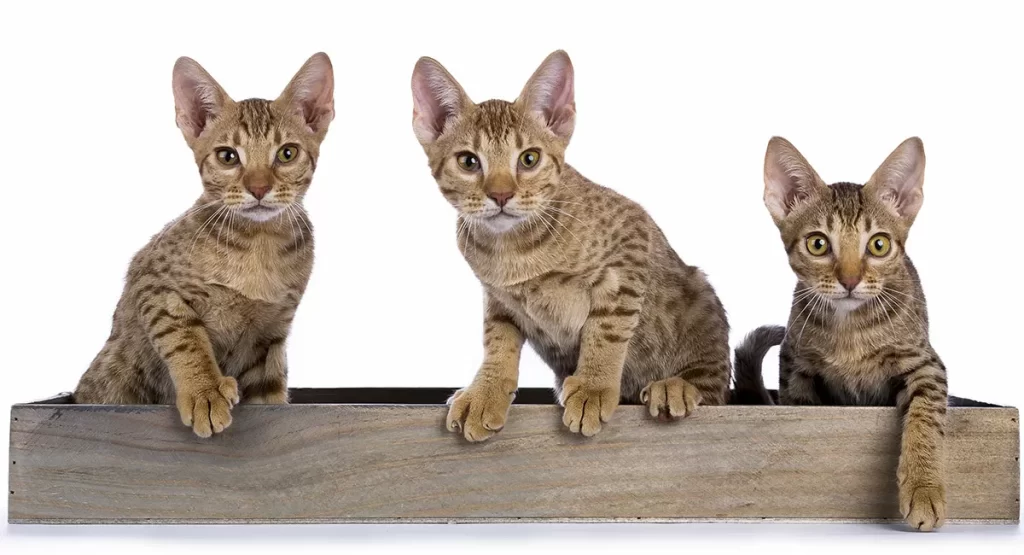
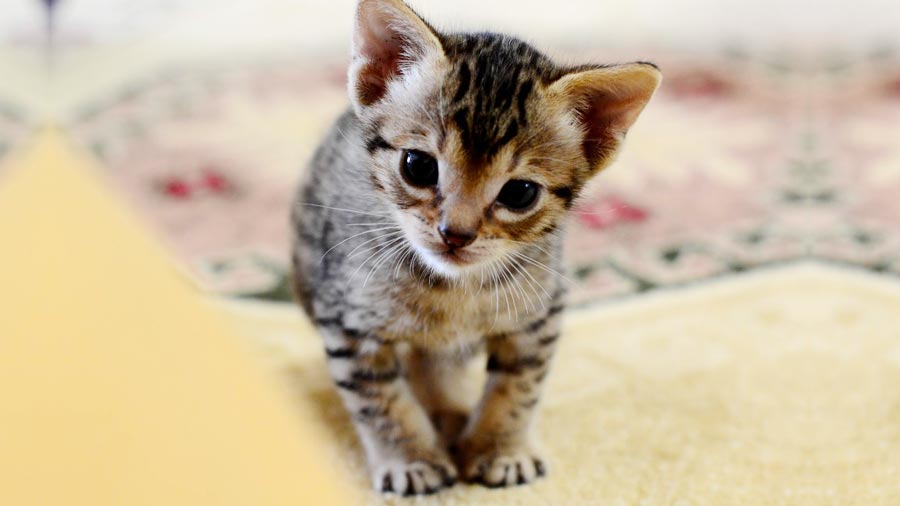
- Make sure that the color of the animal matches the shades prescribed in the standard. If the seller offers a spotted kitten of any unticked suit, this is anyone, but not an Ocicat.
- The champagne shade, as well as the colors of silver-blue, silver-lilac and fawn-silver, are considered the rarest, so you will have to pay more for an Ocicat of this color.
- The most common colors of the breed are all shades of chocolate. So, when buying a brown cat, you can count on a small savings – the price tag for blue and purple cats is much higher.
- If the character of the Ocicat is important, and not its show career and breeding characteristics, you can opt for breed varieties – cats with ticked fur without marks, individuals with solid colors, in which the spots merge with the background, and beauties in marble “fur coats” (the very Aztec cats).
- Pay attention to the behavior of kittens when you appear in the cattery. If the kids hiss, run away and do not get out of the shelter for a long time – this indicates the instability of the psyche of the offspring, which is most likely inherited from the parents.
Ocicat price
In Germany and other European countries, the cost of a pedigree Ocicat varies from 800 to 1,500 euros (approximately 900 – 1600$). To buy a kitten in his homeland, in the USA, you will have to spend about 500-800 dollars on this matter if the individual has a successful exterior, and about 150 dollars if the animal has minor defects in appearance and one of the most common coat colors. In Russia, you need to look for ocicats from breeders who breed rare and exotic cats – monobreed catteries in the country are still in great short supply. The approximate cost of a pet-class kitten with documents and a pure pedigree from domestic sellers is 700$ and more.



